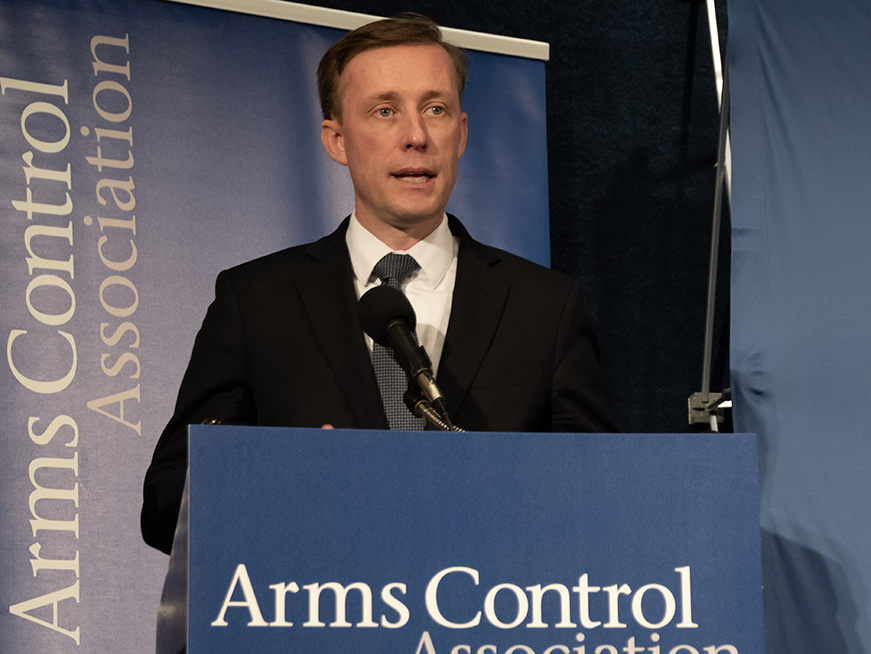"I greatly appreciate your very swift response, and your organization's work in general. It's a terrific source of authoritative information."
A Plan to Reduce Nuclear Dangers in a Time of Peril
July/August 2023
By Daryl G. Kimball
Deteriorating relations between the major nuclear powers have stymied progress on nuclear arms control and disarmament for more than a decade. Russia’s war against Ukraine and its brazen threats of nuclear weapons use have further heightened the risk of nuclear conflict and unconstrained nuclear competition in ways unseen since the darkest days of the Cold War.
 The last remaining treaty limiting the massive U.S. and Russian strategic nuclear arsenals is in jeopardy and will expire in less than 950 days. There are no talks underway on what might replace it. Meanwhile, China is quickly expanding its relatively smaller nuclear arsenal, refusing U.S. overtures for a bilateral nuclear dialogue, and resisting calls to halt fissile material production for nuclear weapons.
The last remaining treaty limiting the massive U.S. and Russian strategic nuclear arsenals is in jeopardy and will expire in less than 950 days. There are no talks underway on what might replace it. Meanwhile, China is quickly expanding its relatively smaller nuclear arsenal, refusing U.S. overtures for a bilateral nuclear dialogue, and resisting calls to halt fissile material production for nuclear weapons.
As bleak as the situation is, reports of the death of nuclear arms control are greatly exaggerated. Last month, the Biden administration outlined a viable path for moving back from the nuclear brink that deserves serious attention and support.
Addressing the Arms Control Association’s annual meeting on June 2, National Security Advisor Jake Sullivan declared that the United States is ready to engage in nuclear arms control diplomacy with Russia and with other nuclear-armed members of the nuclear Nonproliferation Treaty (NPT) “without preconditions.”
Sullivan criticized Russia’s suspension of the New Strategic Arms Reduction Treaty (New START) but noted that “Russia has publicly committed to adhere to the treaty’s central limits.”
“It is in neither [U.S. or Russian] interests to embark on an open-ended competition in strategic nuclear forces,” and the United States is “prepared to stick to the central limits as long as Russia does,” he said.
With New START due to expire in 2026, Sullivan suggested that “rather than waiting to resolve all of our bilateral differences, the United States is ready to engage Russia now to manage nuclear risks and develop a post-2026 arms control framework.”
On June 5, Kremlin spokesperson Dmitry Peskov said that Russia remains open to dialogue with the United States on arms control. He described Sullivan’s comments as “important and positive,” but said Russia wants to learn more about the proposal through formal diplomatic channels.
The negotiation of a complex, bilateral nuclear arms control framework to replace New START would be difficult in good times and extraordinarily difficult so long as Russia's war on Ukraine continues.
Nevertheless, there is scope for the White House and the Kremlin to reach a unilateral, reciprocal arrangement that neither will exceed the deployed strategic warhead limit set by New START until a more permanent arms control arrangement comes into effect. In the absence of such an arrangement, each side could upload warheads on their strategic delivery systems quickly, and China might accelerate its ongoing strategic nuclear buildup.
Importantly, Sullivan also said that U.S. President Joe Biden supports “new multilateral arms control efforts,” involving all five nuclear-armed members of the NPT. “We’re under no illusions that reaching risk reduction and arms control measures in that setting will be easy. But we do believe it is possible,” he said. If pursued smartly and at a senior political level, this might open space for dialogue with China on nuclear restraint.
Sullivan proposed that all five states agree on greater transparency on nuclear doctrines, more effective crisis communications channels, common rules for missile launch notification, and policies to keep “humans in the loop” for command, control, and use of nuclear weapons.
A starting point for more responsible nuclear behavior should be to reaffirm and update the 1973 U.S.-Soviet Agreement on the Prevention of Nuclear War, which pledges that those two states will “refrain from the threat or use of force against the other party, against the allies of the other party and against other countries, in circumstances which may endanger international peace and security.” It requires that “if at any time there is the risk of a nuclear conflict [each side] shall immediately enter into urgent consultations…to avert this risk.”
Although constructive, such “behavioral arms control” alone cannot erase the tensions that can lead to nuclear war, obviate the inherent dangers of nuclear deterrence, or prevent pernicious arms racing. Only a disarmament process leading to the elimination of nuclear weapons will eliminate the threat.
Now is the time for leaders of non-nuclear-weapon states and civil society groups to demand that all five NPT nuclear-armed states engage in good faith efforts to halt and reverse the arms race.
Building on the Biden administration proposals, they should demand that these five observe a global nuclear freeze, by which China, France, and the United Kingdom would cap the overall size of their nuclear arsenals and halt fissile material production so long as Russia and the United States cap their stockpiles while negotiating a new framework to cut their arsenals.
More nuclear weapons make us less secure. Embarking on a safer path through disarmament diplomacy is imperative.
